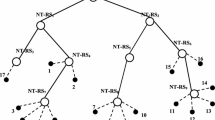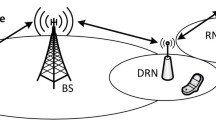Abstract
To enhance throughput and to extend coverage of wireless networks based on IEEE 802.16 standards, relay stations can be implemented. The crucial point influencing the overall system performance is allocation of appropriate amount of resources to individual relay stations depending on their current needs. If resources are not allocated properly, relay stations can experience congestion situations resulting in system throughput decrease and packet delays increase. If the base station is enhanced purely by centrally controlled relay stations, the base station itself is able to dynamically schedule data transmissions of its relays. Nevertheless, decentrally controlled relays schedule data for its users on its own and the base station is no longer capable to allocate the right amount of radio resources for them. The decentrally controlled relays have to ask for radio resources by means of existing scheduling services defined in IEEE 802.16 standard. While utilization of the conventional unsolicited grant service decreases the system capacity, the use of real-time polling or extended real-time polling services results in higher signaling overhead and longer packet delays. In order to maximize system throughput and to minimize packet delays and signaling overhead, we suggest a mechanism that pre-allocates to decentrally controlled relay stations a certain amount of default radio resources while the remaining resources are dynamically shared. The obtained results show that for low traffic load, overhead and packet delays are significantly smaller as relays do not have to ask base stations for resources. On the other hand, at heavy traffic load the system throughput slightly decreases whereas packet delays and signaling overhead are still significantly smaller.














Similar content being viewed by others
References
IEEE Std 802.16-2004 (2004) IEEE Standard for Local and metropolitan area networks, Part 16: Air interface for fixed broadband wireless access systems.
IEEE Std 802.16e-2005 (2006) IEEE Standard for Local and metropolitan area networks, Part 16: Air interface for fixed and mobile broadband wireless access systems.
Molisch, A. (2005). Wireless communication, 1st edn. ISBN:0-470-84887-1.
Nosratinia, A., Hunter, T. E., & Hedayat, A. (2004). Cooperative communication in wireless network. IEEE Communication Magazine, 42, 74–80.
IEEE 802.16j (2007) Baseline document for draft standard for local and metropolitan area networks part 16: Air interface for fixed and mobile broadband wireless access systems.
Hoymann, Ch., Klagges, K. (2005). MAC frame concepts to support multi-hop communication in IEEE 802.16 Networks. Wireless word research forum.
Okuda, M., Zhu, Ch., & Vorel, D. (2008). Multi-hop relay extension for WiMAX network—overview and benfefits of IEEE 802.16j Standard. FUJITSU Science Technology Journal, 44, 292–302.
Upase, B., & Hunukumbure, M. (2008). Dimensioning and cost analysis of multi-hop relay-enabled WiMAX networks. FUJITSU Science Technology Journal, 44, 303–317.
Hoymann, C., Dittrich, M., & Goebbels, S. (2007). Dimensioning Cellular Multi-hop WiMAX Networks. IEEE Mobile WiMAX Symposium, Orlando, Florida, USA, March 2007.
Genc, V., Murphy, S., & Murphy, J. (2008). Performance analysis of transparent relays in 802.16j MMR Networks. In Symposium on Modeling and Optimization in Mobile, Ad Hoc and Wireless Network, Germany, 2008.
Lin, B., Ho, P. H., Xie, L. L., & Shen, X. (2007). Optimal relay station placement in IEEE 802.16j Networks. IWCMC’07, 2007.
Tao, Z., Li, A., Teo, K. H., & Zhang, J. (2007) Frame structure design for IEEE 802.16j Mobile Multi-hop Relay (MMR) Networks. Global Telecommunications Conference (GLOBECOM), p. 4301–4306.
Loa, K. et al. (2007). In-band transparent relay frame structure. IEEE C802.16j-07/179r6.
Leng, X. et al (2007). Non-Transparent relay structure extension for multi-hop (>2 hops) support. IEEE C802.16j-07/145.
Qiuxing, Y., Qiaoyan, L., & Lu, Z. (2007). A frame structure for transparent relay and non/transparent relay coexistence mode. C802.16j-07/280r1.
Ahn, D. H. et al. (2007). Multiframe structure consistent to 802.16e for MR networks. IEEE C802.16-07/162r5.
Yang, H., Lee, L. H., & Lee, M. (2008). A mobility management protocol for multi-hop relay networks. International Conference on Advanced Communication Technology ICACT, p. 37–42.
So, J., Do, M.-S., & Oh, K.-S. (2008). On using load information in multi-hop case. IEEE C802.16j-08/044r2.
Zhu, Ch., Chen, W.-P., & Agre, J. (2006). Measurement method of the network congestion used for adjusting radio resources in a MMR Cell”, IEEE C802.16j-06/145.
Jo, O., & Cho, D.-H. (2007) Traffic adaptive uplink scheduling scheme for relay station in IEEE 802.16 based multi-hop system. Vehicular Technology Conference (VTC-2007 Fall), p. 1679–1683.
IEEE 802.16 m (2008). Evaluation methodology document, IEEE 802.16 m paper No. 08/004r2.
Johnson, D. B., & Maltz, D. A. (1996). Dynamic source routing in ad hoc wireless networks. Mobile Computing, 353, 153–181.
IEEE 802.16j (2007). Multi-hop relay system evaluation methodology (Channel Model and Performance Metric) paper No. 06/013r3.
Mach, P., Bestak, R., & Becvar, Z. (2008). Optimization of Network Entry Procedure in Relay Based WiMAX networks. In Proc. of IWSSIP conference.
Acknowledgments
This work has been performed in the framework of the FP7 project ROCKET IST-215282 STP, which is funded by the EC. The Authors would like to acknowledge the contributions of their colleagues from ROCKET Consortium (http://www.ict-rocket.eu).
Author information
Authors and Affiliations
Corresponding author
Rights and permissions
About this article
Cite this article
Mach, P., Bestak, R. Radio resources allocation for decentrally controlled relay stations. Wireless Netw 17, 133–148 (2011). https://doi.org/10.1007/s11276-010-0269-8
Published:
Issue Date:
DOI: https://doi.org/10.1007/s11276-010-0269-8




